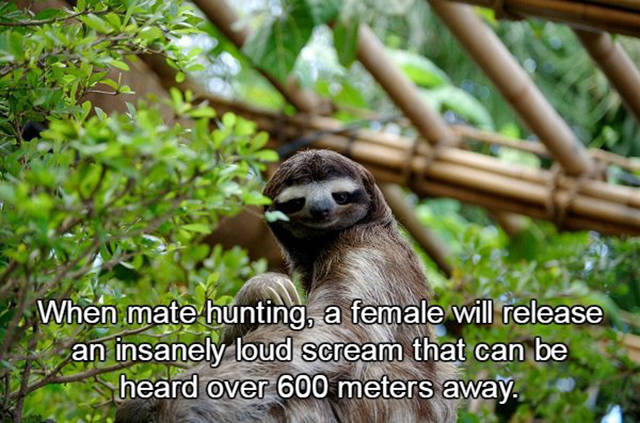

However, there are some cases when their lack of movement keeps females from finding males for longer than one year. They became extinct around 10,000 years ago.Īll sloths are solitary by nature, and come together only to mate. Adult females produce a baby per year. These huge sloths sometimes featured areas of small bone discs that would act as ‘armour plating’ for protection. But ancient sloths of years ago, known as ‘Megatherium’, could grow as large as an Asian elephant. The modern sloth is usually around the size of a medium-sized dog. Their claws also provide a further unexpected deterrent to human hunters – when hanging upside-down in a tree they are held in place by the claws themselves and often do not fall down even if shot from below. The majority of sloth deaths in Costa Rica are from contact with electrical lines and from poachers. The jaguar, the harpy eagle and humans are the biggest dangers to a sloth. LEARN MORE: 10 Facts About the Gray Langur, India’s Terrestrial Monkey Also, three-toed sloths have facial coloring that makes them look like they’re always smiling.

However, two-toed sloths are slightly bigger and tend to spend more time hanging upside-down than the three-toed ones, who will often sit upright in the fork of a tree branch. The two species have similar features: roundish heads, sad-looking eyes, tiny ears, and stubby tails. Sloths are classified by the number of claws on their front feet (two or three). When resting, their temperature is even lower by a few degrees. Sloths maintain a low body temperature even when active, somewhere between 30 to 34 degrees Celsius (or 86 to 93 degrees Fahrenheit). Their metabolic rates are less than half of that expected for a creature of their size. Therefore, the digestive process can take as long as a month or more to complete. This keeps their food and water needs to a minimum.

Sloths have a low metabolic rate and a low body temperature They lap dewdrops off of leaves and fruits, and get additional water from their food.Ĥ. But their diet mainly consists of leaves, fruit and some select fresh green shoots. That’s why sometimes they’re considered omnivores. Sloths are mostly herbivorous, but they may occasionally snack on larval insect, small lizards or other protein-packed snacks (such as bird eggs). International Sloth Day was established in November 2010 as a way of helping people get to know a little bit more about these animals and keep them from going entirely extinct, as has happened to several species of sloths. It is celebrated yearly worldwide on October 20 th. International Sloth Day was created by AIUNAU, a non-profit foundation dedicated to protecting all forms of wildlife. Sloths spend so much time upside down that their fur lies the opposite way to most mammals, growing from the paws up to the body. So, hanging below branches makes them less visible to eagles and their claws can grip the branch without using any energy. Since they’re so slow, they can’t run away from predators. The sloth is a slow-moving mammal that spends most of its life hanging upside down in the trees of the tropical rainforests of Central and South America. What is a sloth and why do they hand upside down? They also regulate their body temperatures by moving in and out of the sun.1. They have reduced muscles, about half the relative weight of most terrestrial mammals, so they cannot afford to keep warm by shivering. Sloths have a metabolic rate that is only 40 to 45 percent of what would be expected for their body weight. Sloths maintain a low, but variable body temperature that ranges from 86 to 93 degrees Fahrenheit (30 to 34 C), which falls during cooler hours of the night, in wet weather, and whenever the animals are inactive. Their hair curves from stomach toward their back this is opposite from most mammals. Their fur also harbors moths, ticks and beetles. This greenish tint camouflages them in the forest canopy. They possess a short, fine undercoat, and an overcoat of longer, coarser hairs, which turn green in moist conditions due to algae growth.Įach strand of brownish-gray hair has grooves running from top to bottom, where two species of blue-green algae grow. The head is short and flat, with a snub nose, rudimentary ears, and large eyes. A sloth's body consists of a short neck with four long limbs of equal length, ending in two 3 to 4 inch (8 to 10 centimeter) long curved claws.


 0 kommentar(er)
0 kommentar(er)
